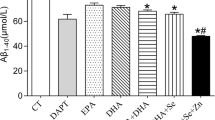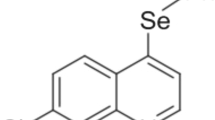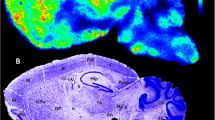Abstract
Choline acetyltransferase (ChAT, acetyl-CoA:choline O-acetyltransferase, EC 2.3.1.6), involved in the learning and memory processes is responsible for the synthesis of acetylcholine. There are many discrepancies in literature concerning ChAT activity during brain aging and the role of amyloid beta peptides in modulation of this enzyme. The aim of the study was to investigate the mechanism of ChAT regulation and age-related alteration of ChAT activity in different parts of the brain. Moreover the effect of Aβ peptides on ChAT activity in adult and aged brain was investigated. The enzyme activity was determined in the brain cortex, hippocampus and striatum in adult (4-months-old), adult-aged (14-months-old) and aged (24-months-old) animals. The highest ChAT activity was observed in the striatum. We found that inhibitors of protein kinase C, A, G and phosphatase A2 have no effect on ChAT activity and that this enzyme is not dependent on calcium ions. About 70% of the total ChAT activity is present in the cytosol. Arachidonic acid significantly inhibited cytosolic form of this enzyme. In the brain cortex and striatum from aged brain ChAT activity is inhibited by 50% and 37%, respectively. The aggregated form of Aβ 25-35 decreased significantly ChAT activity only in the aged striatum and exerted inhibitory effect on this enzyme in adult, however, statistically insignificant. ChAT activity in the striatum was diminished after exposure to 1 mM H2O2. The results from our study indicate that aging processes play a major role in inhibition of ChAT activity and that this enzyme in striatum is selectively sensitive for amyloid beta peptides.
Similar content being viewed by others
REFERENCES
Oda, Y. 1999. Choline acetyltransferase: the structure, distribution and pathologic changes in the central nervous system. Pathol. Int. 49:921–937.
Benishin, C. G. and Carroll, P. T. 1981. Acetylation of choline and homocholine by membrane-bound choline-O-acetyltransferase endings. J. Neurochem. 36:732–740.
Resendes, M. C., Dobransky, T., Ferguson, S. S. G., and Rylett, R. J. 1999. Nuclear localization of the 82–kDa form of human choline acetyltransferase. J. Biol. Chem. 274:19417–19421.
Bruce, G. and Hersh, L. B. 1989. The phosphorylation of choline acetyltransferase. Neurochem. Res. 14:613–620.
Dobransky, T., Davis, W. L., Xiao, G., and Rylett, R. J. 2000. Expression, purification and characterization of recombinant human choline acetyltransferase: phosphorylation of the enzyme regulates catalytic activity. Biochem. J. 349:141–151.
Issa, A. M., Gauthier, S., and Collier, B. 1996. Effects of the phosphatase inhibitors calyculin A and okadaic acid on acetylcholine synthesis and content of rat hippocampal formation. J. Neurochem. 66:1924–1932.
Schmidt, B. M. and Rylett, R. J. 1993. Phosphorylation of rat brain choline acetyltransferase and its relationship to enzyme activity. J. Neurochem. 61:1774–1781.
Bird, T. D., Stranhan, S., Sumi, S. M., and Raskind, M. 1983. Alzheimer's disease: choline acetyltransferase activity in brain tissue from clinical and pathological subgroups. Ann Neurol. 14:284–293.
Nitta, A., Itoh, A., Hasegawa, T., and Nabeshima, T. 1994. β-amyloid protein-induced Alzheimer's disease animal model. Neurosci. Lett. 170:63–66.
Haba, K., Ogawa, N., Kawata, M., and Mori, A. 1988. A method for parallel determination of choline acetyltransferase and muscarinic cholinergic receptors: application in aged-rat brain. Neurochem. Res. 13:951–955.
McGeer, E. G., Fibiger, H. C., McGeer, P. L., and Wickson, V. 1971. Aging and brain enzymes. Exp. Gerontol. 6:391–396.
Michalek, H., Fortuna, S., and Pintor, A. 1989. Age-related differences in brain choline acetyltransferase, cholinesterases andmuscarinic receptor sites in two strains of rats. Neurobiol. Aging. 10:143–148.
Ogawa, N., Asanuma, M., Kondo, Y., Nishibayashi, S., and Mori, A. 1994. Reduced choline acetyltransferase activity and muscarinic M1 receptor levels in aged Fisher 344 rat brains did not parallel their respective mRNA levels. Brain Res. 658:87–92.
Strong, R., Hicks, P., Hsu, L., Bartus, R. T., and Enna, S. J. 1980. Age-related alterations in the rodent brain cholinergic system and behavior. Neurobiol Aging I:59–63.
Waller, S. B. and London, E. D. 1989. Choline acetyltransferase activity and muscarinic binding in brain regions of aging Fischer-344 rats. Neurochem. Int. 14:483–490.
Sirviö, J., Hervonen, A., and Riekkinen, P. J. 1988. Cholinergic binding in the hippocampus of the aging male rat. Comp. Biochem. Physiol. 90C:161–163.
Hoshi, M., Takashima, A., Muryama, M., Yasutake, K., Yoshida, N., Ishiguro, K., Hoshino, T., and Imahori, K. 1997. Nontoxic amyloid β peptide1–42 suppresses acetylcholine synthesis. J. Biol. Chem. 272:2038–2041.
Kar, S., Issa, A. M., Seto, D., Auld, D. S., Collier, B., and Quirion, R. 1998. Amyloid β-peptide inhibits high-affinity choline uptake and acetylcholine release in rat hippocampal slices. J. Neurochem. 70:2179–2187.
Pedersen, W. A., Kloczewiak, M. A., and Blusztajn, J. K. 1996. Amyloid β-protein reduces acetylcholine synthesis in a cell line derived from cholinergic neurons of the basal forebrain. Proc. Natl. Acad. Sci. USA. 93:8068–8071.
Strosznajder, J. B., Zambrzycka, A., Kacprzak, M. D., and Strosznajder, R. P. 1999. Amyloid β peptide 25–35 modulates hydrolysis of phosphoinositides by membrane phospholipase(s) C of adult brain cortex. J. Mol. Neurosci. 12:101–109.
Zambrzycka, A., Strosznajder, R. P., and Strosznajder, J. B. 2000. Aggregated beta amyloid peptide 1–40 decreases Ca21 and cholinergic receptor-mediated phosphoinositide degradation by alteration of membrane and cytosolic phospholipase C in brian cortex. Neurochem. Res. 25:189–196.
Fonnum, F. 1994. A rapid radiometric method for the determination of choline acetyltransferase. J. Neurochem. 24:407–409.
Ninomja, Y. and Kayama, Y. 1998. Inhibition of choline acetyltransferase activity by serum albumin modified with octanoic acid and other fatty acids. Neurochem. Res. 23:1303–1311.
Arita, K., Kobuchi, H., Utsumi, T., Takehara, Y., Akiyama, J., Horton, A. A., and Utsumi, K. 2001. Mechanism of apoptosis in HL-60 cells induced by n-3 and n-6 polyunsaturated fatty acids (11). Biochem. Pharmacol. 62(7):821–828.
Vento, R., D'Alessandro, N., Giuliano, M., Lauricella, M., Carabillo, M., and Tesoriere, G. 2000. Induction of apoptosis by arachidonic acid in human retinoblastoma Y79 cells: involvement of oxidative stress. Exp. Eye. Res. 70(4):503–517.
Yufu, F., Egashira, T., and Yamanaka, Y. 1994. Age-related changes of cholinergic markers in the rat brain. Jpn. J. Pharmacol. 66:247–255.
Baxter, M. G., Frick, K. M., Price, D. L., Breckler, S. J., Markowska, A. L., and Gorman, L. K. 1999. Presynaptic markers of cholinergic function in the rat brain: relationship with age and cognitive status. Neuroscience 89:771–780.
Dournaud, P., Gautron, J. P., Pattou, E., Bons, N., Mestre, N., Petter, A., Kordon, C., and Epelbaum, J. 1994. Choline acetyltransferase and somatostatin levels in aged Microcebus murinus brain. Neurobiol. Aging. 15:727–731.
Pedersen, W. A. and Blusztajn, J. K. 1997. Characterization of the acetylcholine-reducing effect of the amyloid-β peptide in mouse SN56 cells. Neurosci. Lett. 239:77–80.
Author information
Authors and Affiliations
Rights and permissions
About this article
Cite this article
Zambrzycka, A., Alberghina, M. & Strosznajder, J.B. Effects of Aging and Amyloid-β Peptides on Choline Acetyltransferase Activity in Rat Brain. Neurochem Res 27, 277–281 (2002). https://doi.org/10.1023/A:1014951010834
Issue Date:
DOI: https://doi.org/10.1023/A:1014951010834




